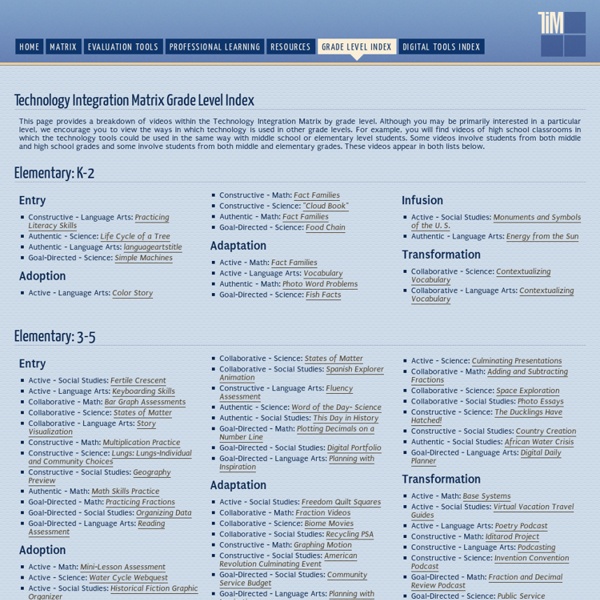



Technology Integration Matrix | Arizona K12 Center What is the Arizona Technology Integration Matrix? The Technology Integration Matrix (TIM) illustrates how teachers can use technology to enhance learning for K-12 students. The TIM incorporates five interdependent characteristics of meaningful learning environments: active, collaborative, constructive, authentic, and goal directed (Jonassen, Howland, Moore, & Marra, 2003). The TIM associates five levels of technology integration (i.e., entry, adoption, adaptation, infusion, and transformation) with each of the five characteristics of meaningful learning environments. Together, the five levels of technology integration and the five characteristics of meaningful learning environments create a matrix of 25 cells. What is in each cell? Within each cell of the Matrix one will find two lessons plans with a short video of the lesson. Download PDF of the Technology Integration Matrix Print this page Characteristics fo the Learning Environment ← → Levels of Technology Integration Into the Curriculum
TPACK Model | Digital Learning Futures TPACK Model Description from the project Resources and references provided by the teaching Teachers to the Future (TTF) project. The Technological Pedagogical Content Knowledge (TPACK) conceptual framework espoused by Mishra and Koehler (2006), underpins much of the national directions for describing use of ICT in learning and for profesisonal work. The TPACK framework “attempts to capture some of the essential qualities of teacher knowledge required for technology integration in teaching, while addressing the complex, multifaceted, and situated nature of this knowledge” (p.1). Specifically it: highlights the nuanced and complex relationships between three forms of knowledge: Pedagogical knowledge (PK), content knowledge (TK); and technological knowledge (TK). The model in a nutshell The Technological Pedagogical Content Knowledge (TPACK) conceptual framework was described originally by Mishra and Koehler (2006). This framework is represented in the diagram. The digitally literate learner:
What is TPACK? | Teaching Teachers for the Future We have understood for a long time that expert teachers are those who can bring together their deep knowledge of subject matter with profound understanding of what is good for learning. The combination has been described as Pedagogical Content Knowledge (PCK) and is more than the simple addition of two parts. The fusion is what enabled expert 20th century teachers to transform subject content and represent it in ways that made it accessible to individual learners in their specific contexts. In the 21st century, Information and Communication Technology (ICT) is providing us with new ways to access and process knowledge in every field. ICT is also transforming pedagogy by providing new ways to engage learners. Expert teachers now are those who can bring together knowledge of subject matter, what is good for learning, and technology (ICT). TPACK - Technological Pedagogical Content Knowledge This professional website was developed by Dr Matthew J. Punya Mishra's web Ideas videos
5 Ways Rapid Technology Change Impacts Education | Education Technology, Apps, Product Reviews, and Social Media – Edudemic Rapid technology change is here to stay. No sense in trying to change the way the world works–at least when you’re messing with the wallets of major corporations. This kind of change introduces threats to education, which we talked about in part 1. There is likely very little that can be actively done to reduce these threats, as they are first economic issues. But we can begin to understand them better. 5 Ways Rapid Technology Change Impacts Education 1. As technology advances at a blistering rate, the inertia of institutions of formal learning keeps them from being able to keep up. Technology policies, teacher growth plans, and even department structures are impotent against this rate of change, and this degree of fragmentation. 2. The mess that is proliferation, fragmentation, and short shelf-life is only ammunition in the gun of naysayers that stand on the periphery–arms neatly folded across their chests–and refuse to adopt new technology. 3. 4. 5. New technology deserves new thinking.
A Few Simple Ways To Introduce Reluctant Colleagues To Technology (Cross-posted at TechLearning) Many years ago I helped operate a soup kitchen on San Jose’s (CA) Skid Row. We were well-meaning, but not the most responsible neighbors. On day I was sweeping around the passed-out men and women on our front porch when a police car drove-up. I’ve often thought about that incident during my nineteen year career as a community organizer and six years as a public school teacher. The issue of educational technology is, I believe, no different. In my community organizing career, I learned that a key to engaging people to move beyond their comfort zone is to first build a relationship — a reciprocal one. Based on the conversations I’ve had with many teachers, here are some of the simple ways I’ve introduced using educational technology as tool reluctant colleagues might want to consider — after I’ve developed or deepened relationships with them. 1) Using a Computer Projector. 2) Using a Document Camera. To Make It Easily Viewable By Other Classmates: